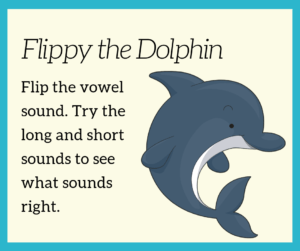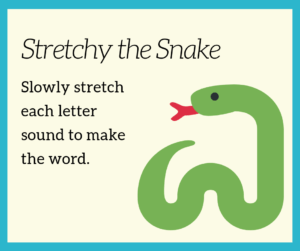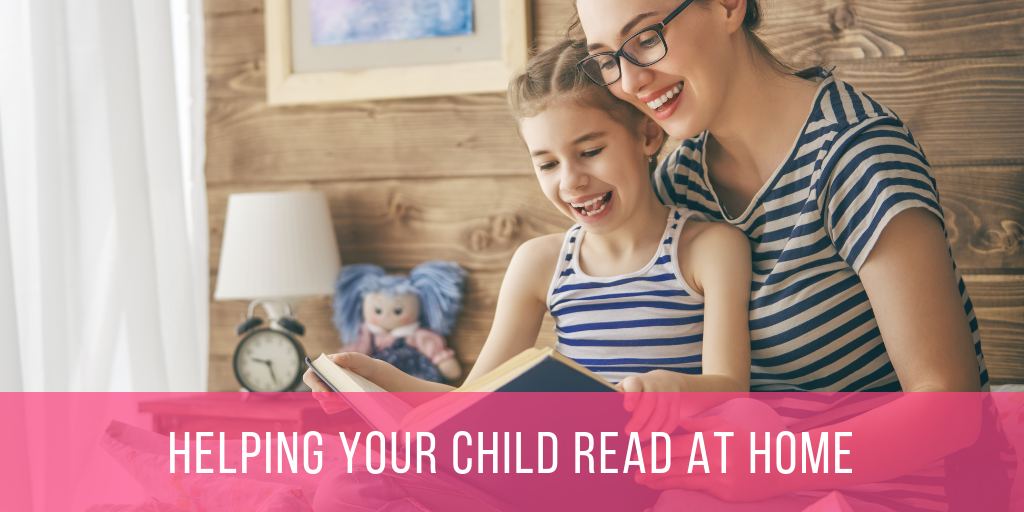I hope you have been practicing your home reading strategies from Part 1 of this blog! Here are 3 more to try at home this week.
Flippy the Dolphin
 This is a key strategy as it encourages children to attend to rules, such as silent e, and to recognize that some letters have two sounds (vowels, C, G and Y). Vowels have two sounds (long and short sounds).
This is a key strategy as it encourages children to attend to rules, such as silent e, and to recognize that some letters have two sounds (vowels, C, G and Y). Vowels have two sounds (long and short sounds).
For example, the long A sound says its own name, such as in the word ‘name’ and the short A sound is present in the word (cat). C and G have hard and soft sounds. C can say it’s hard sound, such as in the word ‘cat’ and say a soft sound (sounds like an S) in the word ‘ice’. Similarly, a hard G can be heard in the word ‘gate’ and the soft G sounds like a J in the word ‘giraffe’. Lastly, Y has three sounds. It can say E such as in “chilly”, I such as in the word “my” as well as the short Y sound, such as in “yo-yo”.
When using the Flippy the Dolphin reading strategy, prompt your child to flip the vowel (or C,G or Y) sound. For example, when trying to read the word “cane”, your child may say “can”. Remind them to flip the A sound and then they will successfully read the word with the long vowel sound.
Stretchy the Snake
 This is the “sound it out” reading strategy. This is definitely a strategy that is used consistently, but just a caution to not heavily rely on this strategy. If so, then reading fluency will become very choppy as every word will be read by isolating the individual sounds before reading whole words. And, as mentioned above, sounding out words will no longer be very successful as words become longer and more complex. Stretchy the Snake is a great strategy to use with beginning readers as they are still learning 3 and 4 letter words and word families (cat,hat,rat,bat, etc,).
This is the “sound it out” reading strategy. This is definitely a strategy that is used consistently, but just a caution to not heavily rely on this strategy. If so, then reading fluency will become very choppy as every word will be read by isolating the individual sounds before reading whole words. And, as mentioned above, sounding out words will no longer be very successful as words become longer and more complex. Stretchy the Snake is a great strategy to use with beginning readers as they are still learning 3 and 4 letter words and word families (cat,hat,rat,bat, etc,).
Another good tip to help stretch out words is to tie in movement (kinaesthetic). For example, with your child, stretch out your arm and use your other hand to tap out the sounds along your outstretched arm. When reading the word ‘sun’, touch your shoulder and say ‘s’, touch your elbow and say the ‘u’ sound, and slide your hand to your wrist as you say the sound for ‘n’. Break the word up once or twice and then blend it into the word ‘sun’ by sliding your hand down your arm in one smooth motion. By combining movement with words, you are creating more connections for your child, which will further deepen their understanding of how words work.
Patience and Struggle
Lastly and very importantly, remember that deeper learning comes from the internal workings of problem-solving. As teachers and parents, we often want to jump in immediately and give the answer to our children. Be mindful as you listen to your child read and when they become stuck on a word, give them a few moments to work it out on their own. This can be one of the most difficult strategies to apply, but it is worth it! Seeing the independence, pride, and smiles that come from our children as they figure out a word on their own is incredibly rewarding and powerful!
The more success they have independently, the greater risks they will take as they continue to read. We want our children to feel independent and that they do not need to rely on adults at every obstacle in their reading. As a rule of thumb, give your child approximately 3 seconds of quiet as they begin to work out the word. If they still have challenges, ask if they would like “time or help”. This empowers your child to make the choice to accept help or to continue working it out on their own.
We hope that the above strategies can help your family with at home reading practice. Always remember that a little bit of reading each day goes a long way! Although the act of reading acquisition is complex and challenging, try to balance challenge with success. Reading should be a fun, enjoyable experience for your family. Happy home reading!
